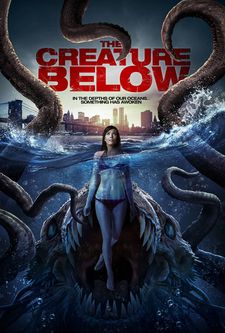 encounters something deep in the ocean_600.jpg) |
| First contact |
It's a creature feature with a penchant for existential terror, a tale of hidden horrors that shifts the action from remote, unexplored realms to an ordinary suburban basement. Stewart Sparke and Paul Butler's affectionate yet deliciously dark slice of Lovecraftian horror The Creature Below is set to make a big impression at this year's Friightfest, so we wanted to know where it all began.
 |
| Paul and Stewart discuss a scene on set. |
"The idea of there being something bigger than what we are currently aware of is fascinating to me," says writer and co-producer Paul. "With our advances in technology, exploration, and the availability of all kinds of information we kind of believe we know everything there is to know and we find solace in that. Turning that notion on its head and presenting people with the alternative view that, as a species, we are small, naive and insignificant is a terrifyingly exciting concept for a writer to sink their teeth into. This particular story also delves into the personal effects on the psyche of obsession and the lengths people will push themselves to. I was inspired by the question of how do seemingly normal people become monsters and what effect would their attempts to hide their true nature have on their loved ones."
Stewart, the film's director, agrees. "When Paul and myself were first looking at story ideas for our first feature film one of the common threads we kept coming back to was that we wanted to draw upon the sense of overwhelming dread and gut-wrenching futility found in Lovecraft’s best work. Whilst that was a huge inspiration for us we also wanted to tell a very human story set in the real world and show what happens when those two universes collide and how it touches our characters living in modern day Britain. What we ended up with was a unique British horror film we think will unsettle and disturb the audience and stand out from what people would consider a typical horror movie."
 confronts Olive (Anna Dawson)_225.jpg) |
| Chief scientist Fletcher (Zach Lee) confronts diver Olive (Anna Dawson). |
It's a particularly strong film in terms of the roles it gives to women, centering on Olive (Anna Dawson), a marine biologist who discovers something unexpected on an ocean dive, and featuring a strong turn from Michaela Longden as her sister. Paul says that this came about partly because of the strong maternal themes in the story but also because he has no interest in outdated stereotypes that suggest women need to be rescued. "We wanted our female characters to be defined by their choices, their actions and motivations, not their physical attributes," he says. "With strong female characters at the helm we were able to flip conventional character tropes and have fun with our male characters. Most the men in this film are weak, objectified or victims and this is most definitely deliberate. It’s not to say men are weak necessarily, it was more to use contrast in character construction to make our strong women appear even stronger by having our weak male characters be even weaker. Hollywood has been pulling off this trick for years by making strong male leads seem even stronger by surrounding them with weak women so to turn that on its head was fun. Having said all this, the decision to create weak, feeble male characters was led by the needs of the story. If Matt [Olive's boyfriend, played by Daniel S Thrace] was a strong, assertive guy then he would have quickly worked out what Olive was up to. As it is, Matt’s timid nature inadvertently allows for Olive's madness to grow. As far as a need to have more female-centred films, I’d certainly like to see more."
 searches for the creature_225.jpg) |
| Olive searches her basement for a shy little eldritch horror. |
"As a horror fan it’s been great to see more and more female driven films, particularly Jennifer Kent’s The Babadook and even more recently with films like You’re Next and The Shallows," adds Stewart. "I’ve seen far too many horror movies where the woman are running into danger and screaming their lungs out waiting for the male hero to rush in and save them that it became a huge point for us to make sure that The Creature Below didn’t fall into that category. Paul did a fantastic job writing these strong female characters and drawing on those clichés to create our male characters whilst still keeping them believable and realistic."
The two were closely involved in finding the right actors, working closely with casting director Lisa Power. "We had Daniel S Thrace onboard to play Matt from the beginning as we had worked with him in the past and was very impressed with his abilities," says Paul. "We have a great relationship with Dan and he was present in the casting to see which actress played best beside him. We were very lucky to have some great actors come to audition and it was a very hard decision for the roles but we couldn’t be happier with the cast we settled on. Everyone gave their all and really believed in the project and elevated the characters they were playing."
Whilst it's one thing to find the right humans, it's another to put the unknowable and unimaginable up there on screen and still make the mystique vital to stories like this work. How did they work around that problem?
"It was not so much about making it scarier but rather keeping it this otherworldly, unnameable being beyond our comprehension," says Stewart. "During pre-production I thought a great deal about how we were going to approach shooting each scene with the creature in order to maintain a sense of mystery and terror. After all, no matter how good a practical effect is, lighting can easily ruin the illusion. Having it be sensitive to light was a useful storytelling tool so having it slide around in the shadows makes perfects sense within the story but also allowed us to create some very creepy moments further built upon by the fantastic sound design by Dave S Walker. Once our baby creature grows into an adult, I intentionally wanted to feed the audience breadcrumbs, letting them see more and more glimpses of ourmonster so that when they finally get to the big reveal it feels earned."
 discuss an upcoming scene 2_225.jpg) |
| Paul Butler guides actor Johnny Vivash |
"Yeah, holding the creature back really helps with the tension and suspense," says Paul "but as fans of monster movies we had to satisfy that craving for monster and we do show the three stages of the creature’s life cycle on screen a fair bit compared to other creature-features of this budget level. We had a great team lead by Neil Stevens and Paul Wilkins create the practical creatures and we wanted to show them off but sometime less is more. We do have some great monster kills in the film though; we made sure we had that onscreen."
Speaking of sound design, where did they find the cute noise that the baby monster makes?
"Dave used crocodile cries as well as actual human baby cries," says Stewart. "This created something that sounded otherworldly but was a very familiar. By instinct as humans we are pre-programmed to attach to the sound of babies crying so we wanted to try and get that across in the film."
"We always wanted the first stage of the creature’s lifecycle to trick Olive into attaching to the creature emotionally," adds Paul. "To do this the creature needed to appear somewhat vulnerable and infant like. Hopefully the audience will also connect with the baby creature and like Olive, be lulled into a false sense of security, all the more impactful when they discover the creature’s true malevolent nature."
 studies the creature_225.jpg) |
| Studying the creature |
This is one of the factors that helps to make the film distinctive, but with so many works out there on similar themes,, were they worried about how they could make this story their own?
"The story certainly has a Lovecraftian vibe but the combinations of otherworldly creatures mixed with elements such as motherhood, madness and obsession all explored in a real world setting gives this film a unique feel and tone. We also have a few plot turns near the end, which tend to catch people off guard, so we hope it’s not a predictable movie," says Paul.
"Yes, I think the grounding of our story in reality is what makes it more distinctive and the way that Paul turned the stereotypical horror movie characters on their head gives it a fresh spin on the typical clichés," says Stewart. "With this being our first film it was important that we made something unique, particularly for a British horror film. It’s especially easy to get a specific idea in your head of what The Creature Below is about from just looking at the poster but I think horror fans are going to be very surprised with how we have approached the subject matter and the characters."
The film was made on a tight budget, but Paul stresses that they felt it was very important to keep production values high. "Everyone involved worked very hard on this to make it look and feel much higher budget than it is. The way Stewart uses camera movement and the way Cal O’Connell (Director of Photography) painted with light to created a cinematic image, all came together to elevate the film in addition to the work of all our other amazing crew members who each added to the film’s unique flavor. We were very lucky to work with such a talented bunch."
 |
| A little horror |
There were clearly some big technical challenges to overcome, with much of the film being shot in low light.
"It was quite a challenge to shoot in low light on a technical level but it was very important to tell the story so we had to find a way to make it work visually," Stewart says. "I wanted Olive’s basement laboratory to have a different feel from the rest of the world and its dark, damp and smoky atmosphere contrasts with the brighter and more vibrant outside world, a place Olive shuns more and more as the creature takes hold of her. We shot the film on the Blackmagic Pocket Cinema camera which, when paired with some superb super 16mm lenses, allowed us to get more light than would normally be possible, and the addition of atmospheric lighting and smoke really helped sell that environment. This, in combination with our practical slimy creature effects made it possible to create a very creepy and claustrophobic environment for the action to take place."
HP Lovecraft's work is an obvious influence there. What were the others? Is there a little bit f John Wyndham's The Kraken Wakes towards the end?
"Stewart actually introduced me to HP Lovecraft’s literary work a few years ago," says Paul. "I absolutely loved it but before that I was already a massive fan of Lovecraft films like In The Mouth Of Madness and Event Horizon. What I loved about both those films is the inescapable doom that you just can't run from, no matter what dimension you hide in! During the script development stage I consumed as much HP Lovecraft as time would allow and sought out films depicting madness and otherworldly entities. The Ninth Gate, The Thing, The Mist, among many others played into the development of the story. Yet the major influence for the tone was Jonathan Glazer's Under The Skin, a powerfully unsettling film."
 makes a discovery as Olive (Anna Dawson) looks on_225.jpg) |
| Matt (Daniel S Thrace) discovers that there are things man was not meant to know |
"Yeah I’ve been a Lovecraft fan for a long time now," says Stewart, "one of my favourite stories being The Shadow Over Innsmouth and I’ve always thought it would make a fantastic TV series. I also love Stuart Gordon’s Lovecraft films including Re-Animator, From Beyond and even his TV movie Dagon and watching them just made me what to make something Lovecraft inspired even more.
"I’m glad you noticed the John Wyndham influence in there! I love The Kraken Wakes and Day Of The Triffids is one of my favourite sci-fi reads, one that I’ve always wanted to adapt into a feature film that’s true to the brilliant book, unlike so many of the other adaptations of the story. 28 Days Later is pretty much an adaptation of Day Of The Triffids with Zombies but I want to see those beautiful Triffids on the big screen!"
Stewart and Paul are both thrilled about getting their film selected for this year's Frightfest.
"I’m overjoyed," says Stewart. "What better place to have it than at one of the world’s best horror festivals? I am really looking forward to watching the film on the big screen with the cast and crew as it will be the first time they will be seeing it. I’m also quite nervous showing it to the well–read Frightfest audience alongside so many great looking horror films so I really hope it goes down well."
 |
| The Creature Below poster |
"I could not be happier!" says Paul. "We got into the second Shortcuts to Hell competition a few years ago in which the grand prize was a shot at making a feature film that would premiere at Frightfest. We got long listed and made the Anthology film but didn't win unfortunately. We did however get some amazing feedback we took into the development of The Creature Below. We had a funny kind of mantra on set that we would go back to Frightfest with our first feature one day! We never thought we would actually be selected, it's such a massive festival so we have took it as a seal of approval for the film which is a big confidence boost for us. It's all very surreal but an amazing experience, I can't wait to see the film play to an audience of hard-core horror fans on the big screen. I'm so excited!"
So what's next for the two of them?
"We are currently developing a slate of horror films we hope to make in the future," says Paul. "We are desperate to get the cameras rolling on the next film as The Creature Below has been well received so far. We are never short of creative ideas and have many concepts at different stages of development but at the end of the day we won’t make anything we don’t want to see on screen ourselves."
"Whilst Paul and I continue to develop our slate of films I’ve been lucky enough to work as associate producer on another horror feature film called Lost In The Shadows with co-writers and Directors Sean Brown and Luke Gosling," adds Stewart. "It’s a completely different type of film to The Creature Below and draws on British folklore and the occult to make a very unsettling and scary story I think will be very exciting to watch.
"We are also keen to keep connecting with the horror community and we have started our own horror film review show, Slice Of Horror, that you can watch on the Dark Rift Films YouTube Channel."
The Creature Below will screen at Frightfest this Saturday, 27 August.





















